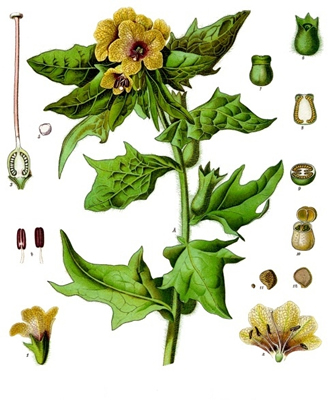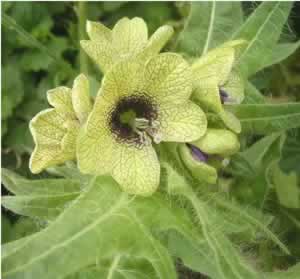Henbane Hyoscyamus niger
- Common Names
- Henbane , Hog bean, stinking nightshade
- Botanical Name
- Hyoscyamus niger
- Family
- SOLANACEAE
Medicinal Uses & Benefits of Henbane
![]() How to Use|
Side Effects |
Plant & Garden|
Folklore
How to Use|
Side Effects |
Plant & Garden|
Folklore
- Properties: * Anodyne * Poison * Psychedelic
- Parts Used: Leaf and seeds
- Constituents: hyoscyamine, scopolamine, and other tropane alkaloids
How to Use: Henbane
Preparation Methods & Dosage :External applications only
Henbane Side Effects: Henbane is poisonous
Plant Description

Koehler's Medicinal-Plants 1887
- Flowers:Off white flowers with purple centers
- Plant Class:Annual or biennial, one to three feet tall
- Leaves: Pointed leaves with prominent veins
- Fruit:
- Preferred Habitat:Waste areas and pastures
- Flowering Season:
- Distribution:
Regional Traditions :European *
History and Traditions & Folklore
The powerful hallucinogen henbane was the most important ritual plant of the ancient Germanic peoples and was connected to the prophetic gods of the Celts, Greeks and Romans. Claudia Muller-Ebeling, Wolf-Deieter Storl Witchcraft Medicine(1998)
 Henbane delights most to grow in saturnine places, and whole cart loads of it may be found near the places where they empty the common Jakes, and scarce a ditch to be found without it growing by it. Ergo, it is an herb of Saturn. The leaves of Henbane do cool all hot inflammations in the eyes, or any other part of the body; and are good to assuage all manner of swellings of the privities, or women's breasts, or elsewhere, if they be boiled in wine, and either applied themselves, or the fomentation warm; it also assuages the pain of the gout, the sciatica, and other pains in the joints which arise from a hot cause. Take notice, that this herb must never be taken inwardly; outwardly, an oil ointment, or plaister of it, is most admirable for the gout, to cool the veneral heat of the reins in the French pox; to stop the tooth- ache, being applied to the aching side: to allay all inflammations, and to help the diseases before premised.
Henbane delights most to grow in saturnine places, and whole cart loads of it may be found near the places where they empty the common Jakes, and scarce a ditch to be found without it growing by it. Ergo, it is an herb of Saturn. The leaves of Henbane do cool all hot inflammations in the eyes, or any other part of the body; and are good to assuage all manner of swellings of the privities, or women's breasts, or elsewhere, if they be boiled in wine, and either applied themselves, or the fomentation warm; it also assuages the pain of the gout, the sciatica, and other pains in the joints which arise from a hot cause. Take notice, that this herb must never be taken inwardly; outwardly, an oil ointment, or plaister of it, is most admirable for the gout, to cool the veneral heat of the reins in the French pox; to stop the tooth- ache, being applied to the aching side: to allay all inflammations, and to help the diseases before premised.
Nicholas Culpeper, 1653











